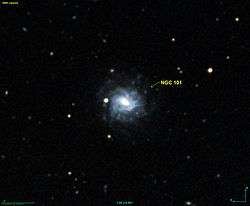NGC 101
NGC 101 is a spiral galaxy estimated to be about 150 million light-years away in the constellation of Sculptor. It was discovered by John Herschel in 1834 and its magnitude is 12.8.[4]
| NGC 101 | |
|---|---|
 DSS image of NGC 101 | |
| Observation data (J2000 epoch) | |
| Constellation | Sculptor |
| Right ascension | 00h 23m 54.614s |
| Declination | −32° 32′ 10.34″[1] |
| Redshift | 0.011284[1] |
| Helio radial velocity | 3383[1] |
| Distance | 149.8 Mly (45.92 Mpc)[2] |
| Apparent magnitude (V) | 12.84[1] |
| Apparent magnitude (B) | 13.36[3] |
| Characteristics | |
| Type | SAB(rs)cd:[1] |
| Size | 119,200 ly (36,560 pc)[1][note 1] |
| Apparent size (V) | 2.2′ × 2.0′[1] |
| Other designations | |
| MGC-05-02-003, PGC 1518[3] | |
Notes
- 2MASS Ks bands used.
gollark: FOR VARIOUS REASONS
gollark: WE NEED TO KNOW WHAT THINGS ARE
gollark: LABELS ARE QUITE IMPORTANT ACTUALLY
gollark: BEE you.
gollark: Please pay attention.
References
- "NED results for object NGC 0101". National Aeronautics and Space Administration / Infrared Processing and Analysis Center. Retrieved 11 March 2017.
- Iglesias-Páramo, J.; et al. (2006). "Star Formation in the Nearby Universe: The Ultraviolet and Infrared Points of View". The Astrophysical Journal Supplement Series. 164 (1): 38–51. arXiv:astro-ph/0601235. Bibcode:2006ApJS..164...38I. doi:10.1086/502628.
- "NGC 101". SIMBAD. Centre de données astronomiques de Strasbourg. Retrieved 11 March 2017.
- "NGC Objects: NGC 100 - 149".
This article is issued from Wikipedia. The text is licensed under Creative Commons - Attribution - Sharealike. Additional terms may apply for the media files.